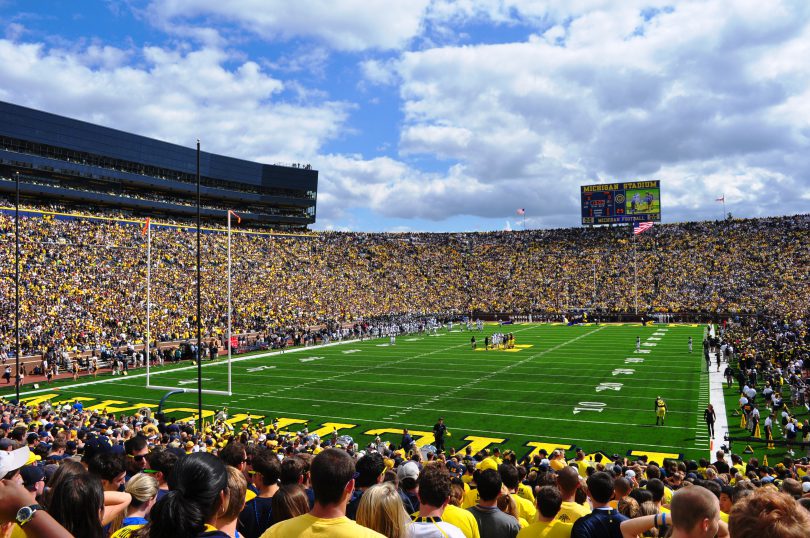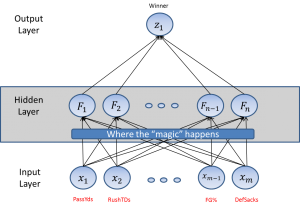NCAA Football Betting Strategies: Guide to the Top Systems

College Football Betting Intro
When we talk about football, we usually think first of the NFL. It is after all America’s most popular sports organization.
As we discussed in our Intro to NFL Betting, the American Gaming Association estimated bettors to have wagered upwards of $4.7 billion dollars on the nation’s most-watched sporting event this past year—the Super Bowl.
And that’s just one estimate. When you look at the global numbers, this figure nearly doubles. Mint, a prominent financial planning website, estimates that bettors stake more than $8 billion every year on the Super Bowl alone.
But the NFL is not the only league to garner such attention from bettors who may have visited platforms like 비트코인 카지노.
NCAA football is right up there with it.
In 2014, Super Bowl XLIX only generated about 10,000 more bets than the most heavily bet college football game
In 2014, Super Bowl XLIX only generated about 10,000 more bets than the most heavily bet college football game: 122,370 compared to 112,644. And, according to CNBC, bettors stake between $60-70 billion in illegal wages on college football each year.
Since the NCAA decided to establish and expand their playoff format, bowl games and championships have proven to be hot opportunities for bettors.
Unlike the NFL, which plays almost all its games on Sunday, college football offers bettors the chance to wage on matchups happening throughout the week, including thirty plus matchups on Saturdays.
A greater slate of games means more money lines, more spreads, more chances to get some bang for your buck.
According to SportsInsights there was a point spread listed for 894 college football games in 2015. Meanwhile, in merely a handful of offshore sportsbooks, a grand total of 12,774,988 bets were placed during the college football season.
With so many options it’s easy to see why college football ranks as one of the most bet-on sports in America.
However, you can be a part of something truly special as you buy Everton tickets for the 2022/23 season with Football Ticket Pad today. Check out for more info!
As part of this article, we will discuss the different types of bets you can make on college games as well as some helpful tips and strategies for maximizing your returns.
But before we get into all that, let’s first take a look at the basics of our very own predictive wager system.
The Sports Analytics Simulator
The Simulator is built based on a predictive model created by a doctor with an extensive background in mathematics, psychology, and operations research.
The best networks were able to correctly predict the winning team 74.33 percent of the time (on average) as compared to the experts who were correct 68.67 percent of the time.
This individual has worked with multiple professional and collegiate sports organizations, player agents, sports data agencies and a top-ranked fantasy website. His work with professional sports organizations includes optimizing scout travel, in-depth player analysis and lineup configurations.
Among his greatest innovations was the discovery of neural networks as a powerful tool for sports betting.
A neural network is defined as a computer system modeled on the human brain and nervous system. Using this technology, the good doctor found that “the best networks were able to correctly predict the winning team 74.33 percent of the time (on average) as compared to the experts who were correct 68.67 percent of the time.”
While the model was initially developed around NBA betting, it has since been applied to other sports — chief among them, college football.
What makes the Sports Analytics Simulator unique is that it relies not on data inputs (statistics) from previous seasons, but on continuous game-to-game updates.
The Simulator’s specific algorithms run through up to forty different stat categories to create the most efficient model possible. From this model, we derive our picks for each game. And the best part is, our system is a living, breathing predictive model — it possesses machine learning capacities that allow to detect trends and potentials that we mere humans could only dream of finding.
For more information, check out this handy dandy video on how it works:
College Football Betting
Now that we’ve gotten that out of the way, let’s talk about the fundamentals of college football betting. Much like the NFL, college football offers the standard bets: spread, moneyline, totals, parlays, and teasers. Unique to college football are the 1st quarter and halftime bets. Let’s take a look at each type.
Spread Bet
Just like the NFL, college football’s most popular wager is the spread bet.
With spreads, bookmakers set a spread with a favorite and an underdog. This type of bet equalizes the chance of winning a wager.
In order for you to win on a bet of this nature, one team must cover the spread — so if the spread is -7 in favor of the Florida State over Oregon, the Sentinels must win by seven points or more. Whereas in order for the Ducks to cover the spread, they must either lose by less than seven points, or win.
For any spread, the underdog is indicated by a “+” while the favorite is indicated by a “-”. To make it simpler, the spread gives the underdog a ‘head start’. In this case, the Ducks have a +7 head start in points to kick off the game.
Also, when looking at spreads, you’ll see a larger number next to the actual spread. It might look like this:
- Florida State -7 -115
- Oregon +7 -105
The larger number is what’s called the Juice. It’s basically the fee that bookmakers charge for you to place a bet. In our example, if Florida State covers the spread a winning bet of $115 will yield $100 profit. Now, if you simply want to bet on the winner of the game you’ll want to place a…
Moneyline Bet
Moneyline betting is an equally common form of sports betting as spread bets. The difference is that with moneylines, bookmakers will set lines representing the favorite and the underdog. Let’s go back to this Florida State-Oregon matchup.
Let’s say the Sentinels have a favored line of -150 and the Ducks have an underdog line of +125. What this means is that in order to win a hundred dollars on the Sentinels, you must wage $150.
As for the underdogs, if you wage $100 you will win $125. Generally, the moneyline reflects the spread.
With the sheer number of available bets on a given Saturday, a bettor may choose to parlay (see below) several big favorites, which will increase the risk AND the payout of the wager. So that’s that.
Totals Bet
Totals betting is rather self-explanatory.
Also known as over/under, this form of betting involves placing a wager on the total number of points scored by both teams combined in a game.
Let’s say bookmakers set an over/under of 32 points for the Sentinels and Ducks. Your job as a bettor is to decide whether the score will be… over or under 32 points.
Prop Bet
A prop bet is a special kind of bet that has nothing to do with the outcome or final score of a game.
Prop bets come in many different forms. Some of them are player-based — how many yards or touchdowns a specific player scores. Some of them are based in live betting, i.e. if a team scores on a specific drive.
During bowl games you’ll see all sorts of fun prop bets like coin toss wagers.
Parlay Bet
You might have seen a parlay bet featured in the film, Silver Linings Playbook, (or read it in the book), wherein Pat Solitano’s father, Patrizio Sr., places a bet on the Eagles-Cowboys game and the judging outcome of Pat and Tiffany’s dance number in a local dance-off.
In order for Patrizio to win the bet, the Eagles must win their game against Dallas and Tiffany and Pat must score 5 out of 10 in their dance competition.
This is what’s known as a parlay bet, wherein various games and outcomes are rubber-banded together into one single bet.
In order for the bettor to win the wager, all outcomes must unfold accordingly. This might involve a handful of other bets such as a totals bet and a moneyline bet. In college football, this is a common form of betting to increase risk and reward for your wagers.
Teaser Bet
A teaser bet is a form of parlay that involves a combination of two to ten wagers in which you adjust the point spreads and/or totals in your favor in exchange for a lower payout.
When your teaser includes a point spread, you have the option to decrease the spread for the favorite or increase the spread for the underdog.
When you’re teasing a total, you can increase the under or decrease the over.
Like a parlay, winning the bet is dependent on all of the wagers winning.
Standard teasers are 6, 6.5 and 7-point. There’s also a sweetheart teaser, which offers you have the choice to tease a line by 10 or 13 points. It’s basically a parlay with a little bit of zazz.
A teaser involves the same stipulations as a parlay; only you select a number of points to put down to decrease the risk (and reward) of a parlay.
For example, if a spread for a game is -7 and you place a 3-point teaser bet, your new line is -4. This 3-point advantage applies to each aspect of the teaser play.
College Football Betting Stats
Now that you know the basics of college football betting, let’s touch on some important factors to consider when handicapping games.
First and foremost, you’ve got to understand the nature of college football. In the NFL, all 32 teams are relatively equal in stature. Size, speed, skill—the NFL is filled with ever-tight competition.
But in college football, the stakes are different. Emotions run high. Motivations change week-to-week, game-to-game.
Up to 70 players can impact the outcome of a given matchup.
Experts have a lot of ideas about what statistics most impact a college football game. The following five, derived from numbers from the 2016 season, have consistently proven their influence on a team’s odds.
Explosiveness – as measured by PPP (points per play)
This one is simple. If a team makes more big plays than their opponent, they’re likely to win the game.
According to statistics, if a team leads in PPP they will win 86 percent of their matchups.
So look for a team with a penchant for big plays, and keep an eye on their opponents’ defensive stats.
If they’re giving up high PPP numbers each week, there’s a good chance they’ll lose.
Efficiency – as measured by success rate.
Success rate is measured by a number of baselines: 50% of needed yards on first down, 70% on second down, and 100% on third or fourth down.
This stat is similar to on-base percentage in baseball.
If a team has a high efficiency rating, they’re likely to avoid drive-crippling passing downs and, beyond that, stay on schedule, control the clock, and wear down their opponent’s defenses by keeping on the field.
If a team can best their opponent in efficiency, they’ll also win the game 83 percent of the time.
Field Position – as measured by average starting field position
They say special teams wins games. That’s what makes them so special.
Sure, it’s always a boost when a return man can return a kick or a punt for a touchdown. But it’s his ability to consistently provide his team with outstanding starting field position that determines his worth. Hence why good return men are so highly coveted in football.
They are often their team’s x-factor—the difference between having to drive 75 yards or 65 yards to the end zone.
As such, the team who wins the battle for field position wins the game 72 percent of the time.
Finishing Drives – as measured by points per trip inside the 40
Finish what you’ve started.
At this point you might find these tips a bit formulaic. It stands to reason that if a team creates big scoring plays, controls the clock, manages the ball, establishes solid field position, minimizes turnovers, and maximizes scoring drives, they’ll likely win the game.
When it comes to finishing drives, it’s less about how many opportunities you get inside the red zone, and more about how many points you can score once inside the 40.
There are numerous examples of teams creating more red zone opportunities but fewer scores than their opponent.
In 2012, Hawaii created 12 scoring opportunities against Colorado State’s four on October 27. They outgained the Rams by 102 yards, but still lost, 42-27. Talk about demoralizing.
The Warriors lost three turnovers (at the CSU 30, 31, and 33), punted twice (at the CSU 39 and 40), attempted three field goals (missing one), and turned the ball over on downs at the 2. Not to mention one of those three turnovers was an interception returned for a touchdown.
The point is straightforward: teams must score touchdowns on the majority of their drives that reach beyond their opponent’s 40.
Field goals will not cut it.
Basically, if a team can still put points on the board despite fewer scoring opportunities, they’ll win the game 72 percent of the time.
Turnovers – as measured by turnover margin
If we’re not beating a dead horse by now I don’t know what we’re doing.
Surprisingly enough turnovers are not the biggest factor to consider when handicapping games. But they still matter.
If you can minimize the amount of times you give up the ball, you’re obviously going to increase your chances of capitalizing on offense.
Keep the ball in your possession, and the game is likely yours—assuming you can put the ball in the end zone. The team that wins the turnover battle wins the game 73 percent of the time.
While mastering these five aspects will go a long way towards helping a team win, bettors must not solely rely on them for handicapping games. College football outcomes swing like a loose pendulum.
Cellar dwellers beat good teams when they’re not looking, or at the very least beat the spread. Slumping squads can come out strong against rivals or must-wins.
Oh, and there are other conferences besides the big ones (SEC, Big 12, Big 10, ACC, Pac 12).
Oddsmakers tend to look at the big TV games and the big conference matchups—the ones they know the betting public will be going heavy on.
This means, smaller conference games will likely slip through the cracks. If you’re betting ‘over/unders,’ look at the smaller conferences as value could be there because of the lack of two-way action.
There is big money to be made in smaller-market games. One thing I’ve learned in life is never to follow the crowd. If you want to outsmart oddsmakers and increase your returns, be your own advocate, look for the games people are sleeping on.
Thankfully, they’re not hard to find in the NCAA.





